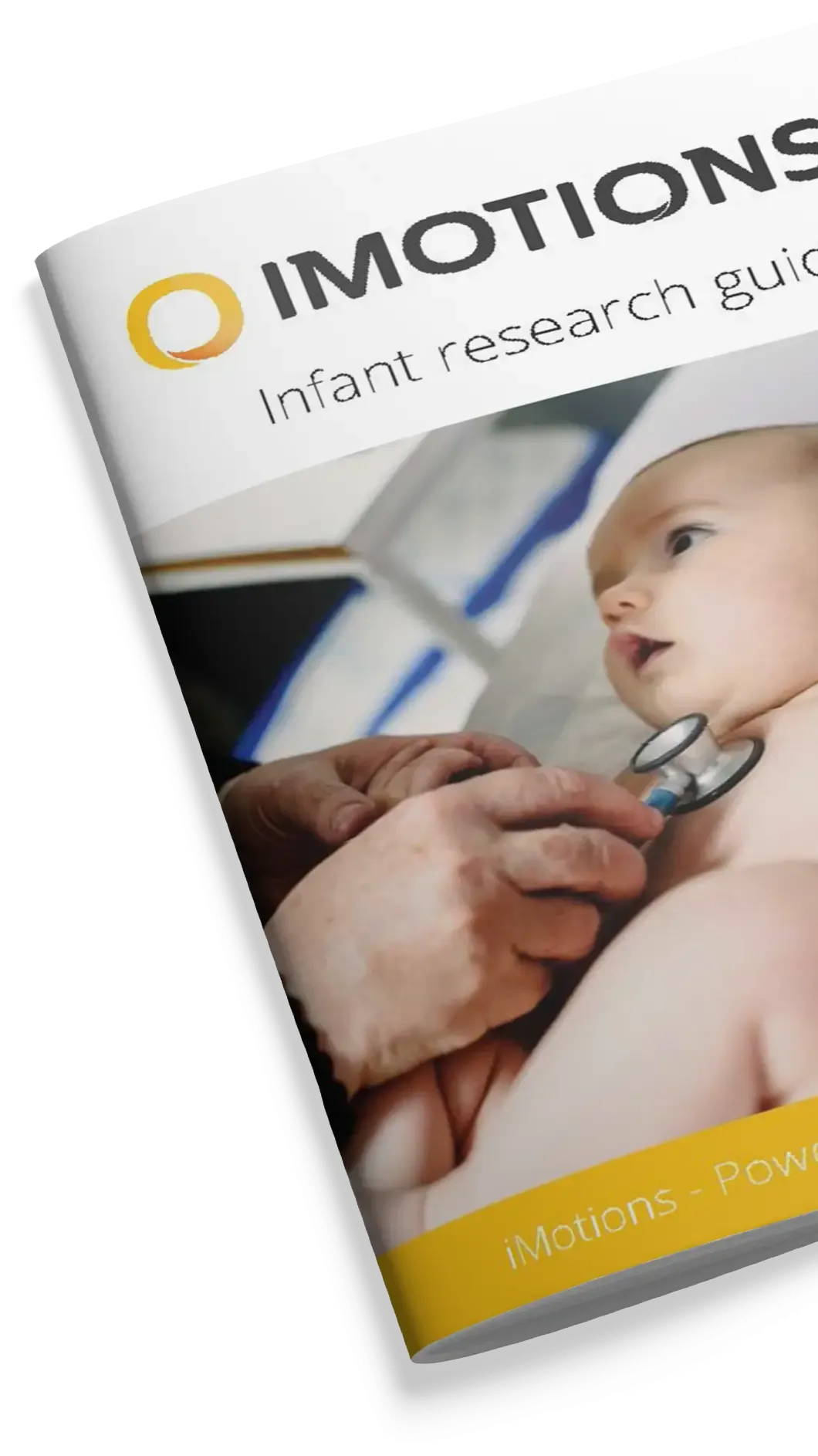This guest post was written for iMotions by our clients Anne Juul Bjertrup, PhD and Kamilla Miskowiak, PhD.

Anne Juul Bjertrup is a psychologist who works with the Neurocognition and Emotion in Affective Disorders (NEAD) Group. She investigates pregnant women and mothers with and without affective disorders. Her primary research interests center around affective cognition in pregnancy and motherhood, understanding risk for postpartum depression and understanding the neurocognitive mechanisms involved in intergenerational transmission of risk from mothers with affective disorders to their children.

Kamilla Miskowiak is a Professor of Cognitive Neuropsychiatry and the director of the NEAD Group. Her research focuses on neurocognition in affective disorders. Emotional cognition in pregnant women and mothers with affective disorders – which her research specifically addresses – is one branch of the NEAD group’s research areas.
Mother-infant communication
Pregnancy and early motherhood involve changes in how the brain processes infant signals of emotion, which enables mothers to ‘tune in to’ and respond with greater vigilance and sensitivity to these signals [1-5]. For example, compared with non-mothers, mothers’ attention is captured more by infant faces [2] and mothers display greater brain activation in social, emotional and empathizing networks when processing infant faces [6]. Moreover, faster attention allocation to infant signals of distress during pregnancy has been associated with better mother-child relations after birth [7]. These cognitive changes and the reorganization of the brain are driven by physiological, psychological and behavioral changes and likely serve an evolutionary adaptive purpose by enhancing mothers’ sensitive caregiving behaviors.
Infants communicate their emotional states through vocalizations, facial expressions and gestures that the mother promptly responds to with infant-directed multimodal communication [8-10]. Importantly, these ‘give-and-take’ interactions occur rapidly and pre-consciously, and the synchrony in the interactions partly hinges on the mothers’ ability to perceive the infant’s signals [11].
Mothers’ accurate understanding, attuned mirroring (i.e. subconscious imitation of emotional states with e.g. facial expressions, gestures and vocalizations) and sensitive behavioral responses to infant emotional signals are thus pivotal for the child’s psychological development [12].

The role of depression and bipolar disorder on perceiving infant emotions
Depression and bipolar disorder (depression and mania) are severe mental illnesses that are associated with difficulties with perceiving, interpreting and responding accurately to emotional signals such as facial expressions [13, 14].
Depression is associated with negative cognitive bias, which is a tendency to perceive and interpret information more negatively. Conversely, patients with bipolar disorder have general emotion processing difficulties and a positive cognitive bias in the perception of emotional information [15, 16].
The cognitive biases and the emotion processing difficulties persist even in remission, i.e. when patients are not experiencing acute depression or mania, and therefore, the disorders may affect the ability to process and respond sensitively to infant signals.
Studies show that pregnant women with depression recognize infant sadness better than happiness and interpret ambiguous infant stimuli negatively [17]. Negatively biased perception of infant stimuli during pregnancy has been associated with more negative behaviors toward the mothers’ own infants a year after birth [18]. Similarly, mothers with postpartum depression display more negative facial expressions and fewer expressions signaling comfort, excitement and happiness toward their infants [19-21].
Such difficulties in understanding and responding attuned and sensitive to infant signals have negative consequences for the child’s development and could therefore contribute to the transmission of risk of mental illness from mothers with depression and bipolar disorder to their children. Indeed, these disorders are highly heritable; children of parents with depression and bipolar disorder have a lifetime risk of developing any mental illness of up to 57 % and 60 %, respectively.
Research using biosensors
Biometric methods have enabled exploration of the psychophysiological, pre-conscious cognitive (including attention, perception and interpretation) and behavioral correlates of emotional information processing.
Cognitive processing of infant emotional signals can be measured at multiple levels by integrating different research methods, including eye tracking, facial expression analysis and galvanic skin responses (GSR) with subjective ratings. This enhances the in-depth scientific understanding of multi-level processing of emotional signals underlying the everyday interactions between mothers and their infants.
Using eye tracking, GSR and facial expression analyses, we recently showed that healthy mothers exhibited more attention and stronger psychophysiological responses to infant stimuli and more positive facial expressions in response to laughing infants than non-mothers [22].
We also investigated mothers with depression and bipolar disorder, who were in remission from affective episodes (depression or mania), and they overall displayed reduced attention and psychophysiological responses to emotional infant stimuli compared to healthy mothers [23]. In addition, mothers with depression displayed increased visual attention toward sad infant faces but avoided intense infant distress and happiness and they displayed more negative facial expressions when listening to intense infant cries, suggesting that they were more negatively affected by them.
Conversely, mothers with bipolar disorder showed more incongruent positive facial expressions to infant distress vs laughter videos. Across all mothers, less attention toward infant stimuli was correlated with delayed infant development. Further, more incongruent positive facial emotions while viewing infant distress correlated with less sensitivity in mothers’ interactions with their infants. Thus, maladaptive cognitive biases in the processing of infant signals were associated with negative outcomes for the infants [23].

We previously showed that negatively biased processing of infant stimuli in pregnant women may be a marker of risk of postpartum depression [24] . Therefore, difficulties in the emotional cognitive processing, including emotional cognitive biases, decreased attention and psychophysiological responses to and misattuned emotional expressions to infant signals, can both indicate risk of depression in the mother and have negative consequences for the child.
This calls for early prophylactic interventions that modify these difficulties. Biosensors may be used to not only measure cognitive processing of emotional infant signals but also to change them by continuously measuring a response (e.g. visual attention or facial expression) and provide real-time feedback. Such biofeedback paradigms can train the ability to voluntarily control a response that normally occurs pre-consciously. In the research field of mother-infant interactions such paradigms may help enhance mothers’ ability to pay attention to infant signals and to sensitively mirror infant emotional states.
A great advantage of biofeedback training paradigms is that they can modify the task to the responses of the individual, which will provide personally sensitive emotional cognitive training.
Conclusion
Biosensors are sensitive to variation in multiple correlates of cognitive processing of and responses to emotional stimuli and can therefore help identify subtle but prolonged psychological risk factors in the transmission of risk from parents to their children. Ultra-early identification of subtle risk can lead to early intervention and prevention of an adverse developmental course for the child and ultimately prevent intergenerational transmission of risk of mental illness.
Webinar
On May 31st, 2022, iMotions hosted a webinar with Anne Juul Bjertrup focusing on the research in this article as well as where the research has taken her since. The full webinar can be watched below.
Infant Research
The Complete Pocket Guide
- 32 pages of comprehensive material on infant research
- Valuable infant research insights (with examples)
- Learn how to take your research to the next level

References
1. Thompson-Booth, C., et al., I can’t take my eyes off of you: Attentional allocation to infant, child, adolescent and adult faces in mothers and non-mothers. PLoS One, 2014. 9(10): p. e109362.
2. Thompson‐Booth, C., et al., Here’s looking at you, kid: Attention to infant emotional faces in mothers and non‐mothers. Developmental Science, 2014. 17(1): p. 35-46.
3. Dudek, J., et al., Changes in Cortical Sensitivity to Infant Facial Cues From Pregnancy to Motherhood Predict Mother–Infant Bonding. Child Development, 2020. 91(1): p. e198-e217.
4. Hoekzema, E., et al., Pregnancy leads to long-lasting changes in human brain structure. Nat Neurosci, 2017. 20(2): p. 287-296.
5. Hoekzema, E., et al., Becoming a mother entails anatomical changes in the ventral striatum of the human brain that facilitate its responsiveness to offspring cues. Psychoneuroendocrinology, 2020. 112.
6. Zhang, K., et al., Brain Responses to Emotional Infant Faces in New Mothers and Nulliparous Women. Scientific reports, 2020. 10(1): p. 9560-9560.
7. Pearson, R.M., S.L. Lightman, and J. Evans, Attentional processing of infant emotion during late pregnancy and mother-infant relations after birth. Arch Womens Ment Health, 2011. 14(1): p. 23-31.
8. Feldman, R., Parent–infant synchrony and the construction of shared timing; physiological precursors, developmental outcomes, and risk conditions. Journal of Child Psychology and Psychiatry, 2007. 48(3-4): p. 329-354.
9. Beebe, B., et al., A systems view of mother-infant face-to-face communication. Developmental psychology, 2016. 52(4): p. 556-571.
10. Cohn, J.F. and E.Z. Tronick, Mother–infant face-to-face interaction: The sequence of dyadic states at 3, 6, and 9 months. Developmental Psychology, 1987. 23(1): p. 68-77.
11. Papoušek, H. and M. Papoušek, Intuitive parenting, in Handbook of parenting: Biology and ecology of parenting, Vol. 2, 2nd ed. 2002, Lawrence Erlbaum Associates Publishers: Mahwah, NJ, US. p. 183-203.
12. Fonagy, P., Affect regulation, mentalization, and the development of the self. 2007.
13. Miskowiak, K.W. and A.F. Carvalho, 'Hot' cognition in major depressive disorder: a systematic review. CNS Neurol Disord Drug Targets, 2014. 13(10): p. 1787-803.
14. de Brito Ferreira Fernandes, F., et al., Facial emotion recognition in euthymic patients with bipolar disorder and their unaffected first-degree relatives. Compr Psychiatry, 2016. 68: p. 18-23.
15. Gruber, J., Can Feeling Too Good Be Bad?: Positive Emotion Persistence (PEP) in Bipolar Disorder. Current Directions in Psychological Science, 2011. 20(4): p. 217-221.
16. Kærsgaard, S., et al., Increased sensitivity to positive social stimuli in monozygotic twins at risk of bipolar vs. unipolar disorder. Journal of Affective Disorders, 2018. 232: p. 212-218.
17. Webb, R. and S. Ayers, Cognitive biases in processing infant emotion by women with depression, anxiety and post-traumatic stress disorder in pregnancy or after birth: A systematic review. Cogn Emot, 2015. 29(7): p. 1278-94.
18. Romero, G., et al., Maternal prenatal depression, PTSD, and problematic parenting: the mediating role of maternal perceptions of infant emotion. Journal of Reproductive and Infant Psychology, 2020: p. 1-15.
19. Cohn, J., et al., Face-to-Face Interactions of Postpartum Depressed and Nondepressed Mother-Infant Pairs at 2 Months. Dev Psychol, 1990. 26(1): p. 15-23.
20. Field, T., Maternal depression effects on infants and early interventions. Prev Med, 1998. 27(2): p. 200-3.
21. Field, T., et al., Depressed mothers who are “good interaction” partners versus those who are withdrawn or intrusive. Infant Behavior & Development, 2003. 26(2): p. 238-252.
22. Bjertrup, A., et al., Neurocognitive processing of infant stimuli in mothers and non-mothers: psychophysiological, cognitive and neuroimaging evidence. Social Cognitive and Affective Neuroscience, 2021. 16(4): p. 428-438.
23. Bjertrup, A.J., et al., Processing of infant emotion in mothers with mood disorders and implications for infant development. Psychological Medicine, 2021: p. 1-11.
24. Bjertrup, A.J., et al., Cognitive processing of infant stimuli in pregnant women with and without affective disorders and the association to postpartum depression. European Neuropsychopharmacology, 2021. 42: p. 97-109.











